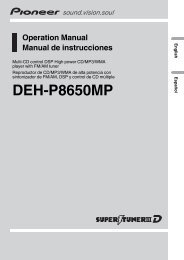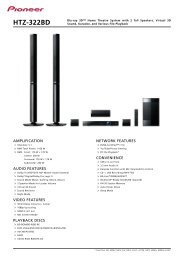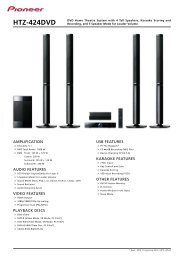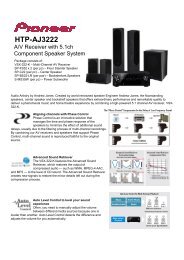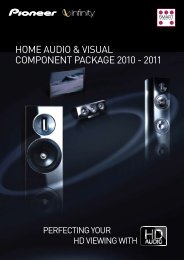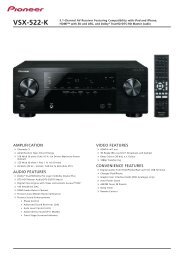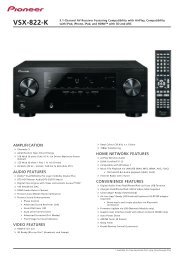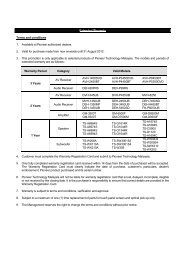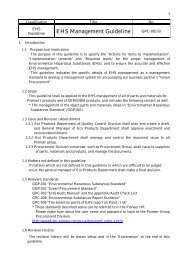Blu-ray Disc PLAYER - Pioneer
Blu-ray Disc PLAYER - Pioneer
Blu-ray Disc PLAYER - Pioneer
Create successful ePaper yourself
Turn your PDF publications into a flip-book with our unique Google optimized e-Paper software.
Wallace article is copyright ACM and IEEE, and it may not be used for commercial<br />
purposes.<br />
A somewhat less technical, more leisurely introduction to JPEG can be found in<br />
The Data Compression Book by Mark Nelson and Jean-loup Gailly, published by<br />
M&T Books (New York), 2nd ed. 1996, ISBN 1-55851-434-1. This book provides good<br />
explanations and example C code for a multitude of compression methods<br />
including JPEG. It is an excellent source if you are comfortable reading C code but<br />
don’t know much about data compression in general. The book’s JPEG sample<br />
code is far from industrial-strength, but when you are ready to look at a full<br />
implementation, you’ve got one here...<br />
The best full description of JPEG is the textbook “JPEG Still Image Data<br />
Compression Standard” by William B. Pennebaker and Joan L. Mitchell, published<br />
by Van Nostrand Reinhold, 1993, ISBN 0-442-01272-1. Price US$59.95, 638 pp. The<br />
book includes the complete text of the ISO JPEG standards (DIS 10918-1 and draft<br />
DIS 10918-2). This is by far the most complete exposition of JPEG in existence, and<br />
we highly recommend it.<br />
The JPEG standard itself is not available electronically; you must order a paper copy<br />
through ISO or ITU. (Unless you feel a need to own a certified official copy, we<br />
recommend buying the Pennebaker and Mitchell book instead; it’s much cheaper<br />
and includes a great deal of useful explanatory material.) In the USA, copies of the<br />
standard may be ordered from ANSI Sales at (212) 642-4900, or from Global<br />
Engineering Documents at (800) 854-7179. (ANSI doesn’t take credit card orders,<br />
but Global does.) It’s not cheap: as of 1992, ANSI was charging $95 for Part 1 and<br />
$47 for Part 2, plus 7% shipping/handling. The standard is divided into two parts,<br />
Part 1 being the actual specification, while Part 2 covers compliance testing<br />
methods. Part 1 is titled “Digital Compression and Coding of Continuous-tone Still<br />
Images, Part 1: Requirements and guidelines” and has document numbers ISO/<br />
IEC IS 10918-1, ITU-T T.81. Part 2 is titled “Digital Compression and Coding of<br />
Continuous-tone Still Images, Part 2: Compliance testing” and has document<br />
numbers ISO/IEC IS 10918-2, ITU-T T.83.<br />
Some extensions to the original JPEG standard are defined in JPEG Part 3, a newer<br />
ISO standard numbered ISO/IEC IS 10918-3 and ITU-T T.84. IJG currently does not<br />
support any Part 3 extensions.<br />
The JPEG standard does not specify all details of an interchangeable file format.<br />
For the omitted details we follow the “JFIF” conventions, revision 1.02. A copy of the<br />
JFIF spec is available from:<br />
Literature Department<br />
C-Cube Microsystems, Inc.<br />
1778 McCarthy Blvd.<br />
Milpitas, CA 95035<br />
phone (408) 944-6300, fax (408) 944-6314<br />
A PostScript version of this document is available by FTP at ftp://ftp.uu.net/<br />
graphics/jpeg/jfif.ps.gz. There is also a plain text version at ftp://ftp.uu.net/<br />
graphics/jpeg/jfif.txt.gz, but it is missing the figures.<br />
The TIFF 6.0 file format specification can be obtained by FTP from ftp://ftp.sgi.com/<br />
graphics/tiff/TIFF6.ps.gz. The JPEG incorporation scheme found in the TIFF 6.0<br />
spec of 3-June-92 has a number of serious problems. IJG does not recommend use<br />
of the TIFF 6.0 design (TIFF Compression tag 6). Instead, we recommend the JPEG<br />
design proposed by TIFF Technical Note #2 (Compression tag 7). Copies of this<br />
Note can be obtained from ftp.sgi.com or from ftp://ftp.uu.net/graphics/jpeg/. It is<br />
expected that the next revision of the TIFF spec will replace the 6.0 JPEG design<br />
with the Note's design. Although IJG's own code does not support TIFF/JPEG, the<br />
free libtiff library uses our library to implement TIFF/JPEG per the Note. libtiff is<br />
available from ftp://ftp.sgi.com/graphics/tiff/.<br />
ARCHIVE LOCATIONS<br />
The “official” archive site for this software is ftp.uu.net (Internet address<br />
192.48.96.9). The most recent released version can always be found there in<br />
directory graphics/jpeg. This particular version will be archived as ftp://ftp.uu.net/<br />
graphics/jpeg/jpegsrc.v6b.tar.gz. If you don’t have direct Internet access, UUNET’s<br />
archives are also available via UUCP; contact help@uunet.uu.net for information<br />
on retrieving files that way.<br />
Numerous Internet sites maintain copies of the UUNET files. However, only<br />
ftp.uu.net is guaranteed to have the latest official version.<br />
You can also obtain this software in DOS-compatible “zip” archive format from the<br />
SimTel archives (ftp://ftp.simtel.net/pub/simtelnet/msdos/graphics/), or on<br />
CompuServe in the Graphics Support forum (GO CIS:GRAPHSUP), library 12 JPEG<br />
Tools. Again, these versions may sometimes lag behind the ftp.uu.net release.<br />
The JPEG FAQ (Frequently Asked Questions) article is a useful source of general<br />
information about JPEG. It is updated constantly and therefore is not included in<br />
this distribution. The FAQ is posted every two weeks to Usenet newsgroups<br />
comp.graphics.misc, news.answers, and other groups. It is available on the World<br />
Wide Web at http://www.faqs.org/faqs/jpeg-faq/ and other news.answers archive<br />
sites, including the official news.answers archive at rtfm.mit.edu: ftp://<br />
rtfm.mit.edu/pub/usenet/news.answers/jpeg-faq/. If you don't have Web or FTP<br />
access, send e-mail to mail-server@rtfm.mit.edu with body<br />
send usenet/news.answers/jpeg-faq/part1<br />
send usenet/news.answers/jpeg-faq/part2<br />
RELATED SOFTWARE<br />
Numerous viewing and image manipulation programs now support JPEG. (Quite a<br />
few of them use this library to do so.) The JPEG FAQ described above lists some of<br />
the more popular free and shareware viewers, and tells where to obtain them on<br />
Internet.<br />
If you are on a Unix machine, we highly recommend Jef Poskanzer’s free<br />
PBMPLUS software, which provides many useful operations on PPM-format image<br />
files. In particular, it can convert PPM images to and from a wide range of other<br />
formats, thus making cjpeg/djpeg considerably more useful. The latest version is<br />
distributed by the NetPBM group, and is available from numerous sites, notably<br />
ftp://wuarchive.wustl.edu/graphics/graphics/packages/NetPBM/. Unfortunately<br />
PBMPLUS/NETPBM is not nearly as portable as the IJG software is; you are likely<br />
to have difficulty making it work on any non-Unix machine.<br />
A different free JPEG implementation, written by the PVRG group at Stanford, is<br />
available from ftp://havefun.stanford.edu/pub/jpeg/. This program is designed for<br />
research and experimentation rather than production use; it is slower, harder to<br />
use, and less portable than the IJG code, but it is easier to read and modify. Also,<br />
the PVRG code supports lossless JPEG, which we do not. (On the other hand, it<br />
doesn’t do progressive JPEG.)<br />
FILE FORMAT WARS<br />
Some JPEG programs produce files that are not compatible with our library. The<br />
root of the problem is that the ISO JPEG committee failed to specify a concrete file<br />
format. Some vendors “filled in the blanks” on their own, creating proprietary<br />
formats that no one else could read. (For example, none of the early commercial<br />
JPEG implementations for the Macintosh were able to exchange compressed files.)<br />
The file format we have adopted is called JFIF (see REFERENCES). This format has<br />
been agreed to by a number of major commercial JPEG vendors, and it has become<br />
the de facto standard. JFIF is a minimal or “low end” representation. We<br />
recommend the use of TIFF/JPEG (TIFF revision 6.0 as modified by TIFF Technical<br />
Note #2) for “high end” applications that need to record a lot of additional data<br />
about an image. TIFF/JPEG is fairly new and not yet widely supported,<br />
unfortunately.<br />
The upcoming JPEG Part 3 standard defines a file format called SPIFF. SPIFF is<br />
interoperable with JFIF, in the sense that most JFIF decoders should be able to read<br />
the most common variant of SPIFF. SPIFF has some technical advantages over<br />
JFIF, but its major claim to fame is simply that it is an official standard rather than<br />
an informal one. At this point it is unclear whether SPIFF will supersede JFIF or<br />
whether JFIF will remain the de-facto standard. IJG intends to support SPIFF once<br />
the standard is frozen, but we have not decided whether it should become our<br />
default output format or not. (In any case, our decoder will remain capable of<br />
reading JFIF indefinitely.)<br />
Various proprietary file formats incorporating JPEG compression also exist. We<br />
have little or no sympathy for the existence of these formats. Indeed, one of the<br />
original reasons for developing this free software was to help force convergence on<br />
common, open format standards for JPEG files. Don’t use a proprietary file format!<br />
TO DO<br />
The major thrust for v7 will probably be improvement of visual quality. The current<br />
method for scaling the quantization tables is known not to be very good at low Q<br />
values. We also intend to investigate block boundary smoothing, “poor man’s<br />
variable quantization”, and other means of improving quality-vs-file-size<br />
performance without sacrificing compatibility.<br />
In future versions, we are considering supporting some of the upcoming JPEG Part<br />
3 extensions --- principally, variable quantization and the SPIFF file format.<br />
As always, speeding things up is of great interest.<br />
Please send bug reports, offers of help, etc. to jpeg-info@uunet.uu.net.<br />
libupnp<br />
Copyright (c) 2000-2003 Intel Corporation<br />
All rights reserved.<br />
Redistribution and use in source and binary forms, with or without modification,<br />
are permitted provided that the following conditions are met:<br />
* Redistributions of source code must retain the above copyright notice, this list<br />
of conditions and the following disclaimer.<br />
* Redistributions in binary form must reproduce the above copyright notice, this<br />
list of conditions and the following disclaimer in the documentation and/or<br />
other materials provided with the distribution.<br />
* Neither name of Intel Corporation nor the names of its contributors may be<br />
used to endorse or promote products derived from this software without<br />
specific prior written permission.<br />
THIS SOFTWARE IS PROVIDED BY THE COPYRIGHT HOLDERS AND<br />
CONTRIBUTORS<br />
“AS IS” AND ANY EXPRESS OR IMPLIED WARRANTIES, INCLUDING, BUT NOT<br />
LIMITED TO, THE IMPLIED WARRANTIES OF MERCHANTABILITY AND FITNESS<br />
FOR A PARTICULAR PURPOSE ARE DISCLAIMED. IN NO EVENT SHALL INTEL OR<br />
CONTRIBUTORS BE LIABLE FOR ANY DIRECT, INDIRECT, INCIDENTAL, SPECIAL,<br />
EXEMPLARY, OR CONSEQUENTIAL DAMAGES (INCLUDING, BUT NOT LIMITED<br />
TO, PROCUREMENT OF SUBSTITUTE GOODS OR SERVICES; LOSS OF USE,<br />
DATA, OR PROFITS; OR BUSINESS INTERRUPTION) HOWEVER CAUSED AND<br />
ON ANY THEORY OF LIABILITY, WHETHER IN CONTRACT, STRICT LIABILITY, OR<br />
07<br />
57<br />
En



